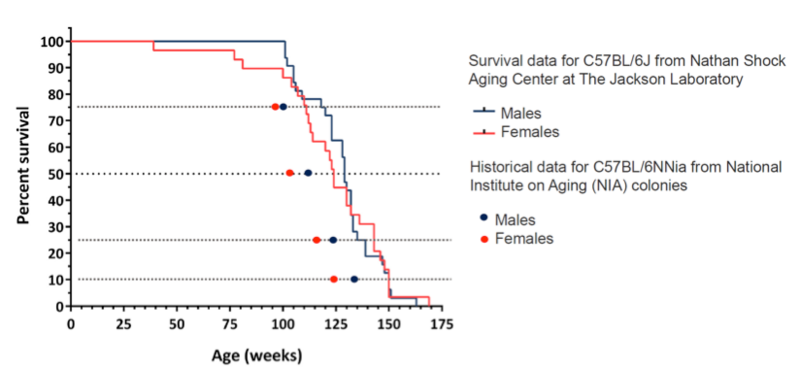What is a normal phenotype for aging mice?
Blog PostNo substitute for proper controls
When making a determination as to whether an experimental outcome is related to a mutation or treatment, there is no substitute for proper controls: contemporary littermate or colony-mates housed in the same environment that lack the mutation of interest or are untreated. The figure below highlights differences in survival between two different substrains of C57BL/6 mice, C57BL/6J mice from a study conducted at the Nathan Shock Aging Center at JAX, and C57BL/6NNia mice from the National Institute on Aging. The difference underscores the importance of proper control selection and that C57BL/6J substrains are not interchangeable in this respect.

The next best options
Sometimes there is a need for assessing whether a phenotype is even remotely similar to what has been observed by others. For such cases, the following resources could be helpful:
- Mouse Phenome Database - A collaborative standardized collection of measured data on a variety of mouse strains that contains several datasets from aging-related studies.
- Mouse Genome Informatics - A centralized reference that integrates genetic, genomic, and biological data. It is recommended for finding gene names, official mouse nomenclature, expression data, phenotype summaries, and references.
- Published Literature - To reduce time spent searching for publications using that strain, every mouse strain at JAX has a datasheet that includes references related to the strain.
- Books – Not everything is online. For investigators working with aged C57BL/6J mice, a potentially useful book is Comparative Anatomy and Histology: a Mouse and Human Atlas (see reference list). The reference contains images of the normal gross and histologic appearance of all organ systems in adult C57BL/6J mice.
- Guide: Aged C57BL/6J Mice for Research Studies - A more extended reference list (books and published manuscripts) is available in this resource.
The resources provided here will hopefully provide the information needed to determine if your phenotypic observations are unique or normal for the aging mice in your study.
JAX provides study-ready C57BL/B6 males and females that are between 25-78 weeks of age. These mice are managed by JAX’s Genetic Stability Program and husbandry experts to minimize genetic drift. Visit Aged C57Bl/B6 mouse page to learn more.
References
- Treuting, Piper M., Suzanne M. Dintzis, Charles W. Frevert, H. Denny Liggitt, and Kathleen S. Montine. 2012.Comparative anatomy and histology : a mouse and human atlas (Elsevier/Academic Press: Amsterdam ; Boston).
- Turturro, A., W. W. Witt, S. Lewis, B. S. Hass, R. D. Lipman, and R. W. Hart. 1999. 'Growth curves and survival characteristics of the animals used in the Biomarkers of Aging Program',J Gerontol A Biol Sci Med Sci, 54: B492-501. PMID: 10619312
- Maddatu, T. P., S. C. Grubb, C. J. Bult, and M. A. Bogue. 2012. 'Mouse Phenome Database (MPD)',Nucleic Acids Res, 40: D887-94. PMID: 22102583
- Eppig, J. T., C. L. Smith, J. A. Blake, M. Ringwald, J. A. Kadin, J. E. Richardson, and C. J. Bult. 2017. 'Mouse Genome Informatics (MGI): Resources for Mining Mouse Genetic, Genomic, and Biological Data in Support of Primary and Translational Research',Methods Mol Biol, 1488: 47-73. PMID: 27933520
Recommended Resources:
- The Jackson Laboratory has study-ready aged C57BL/6J males and females available between 25 – 78 weeks of age.
- Guide: Aged C57BL/6J Mice for Research Studies
- On-Demand Webinar: Research Using Aged B6 Mice - Considerations, Applications, and Best Practices
- Aging-related studies in the Mouse Phenome Database
- Three ways a B6J mouse differs from B6N and why it should matter to your research
